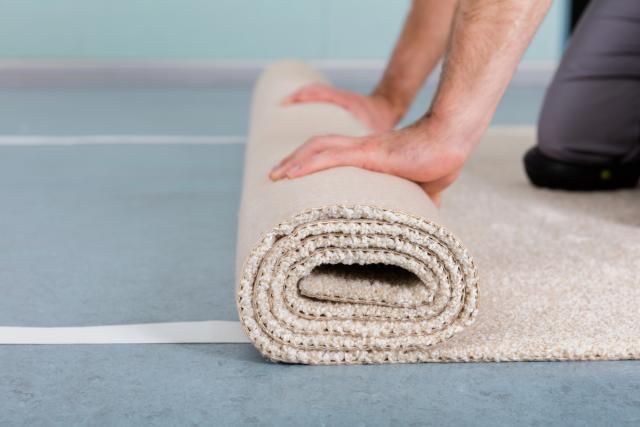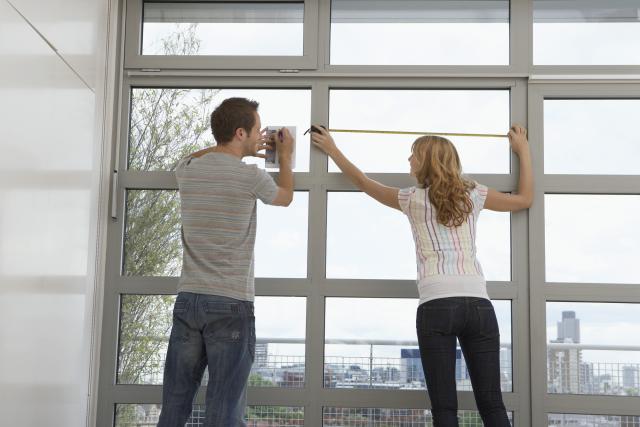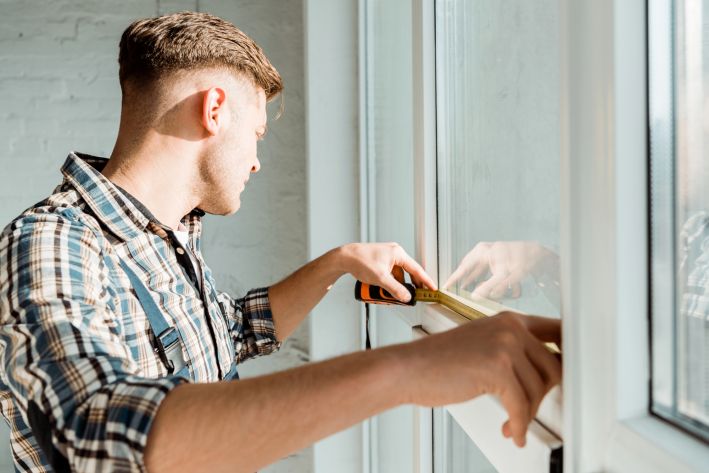
Step‑by‑Step Guide: How to Install Carpet Yourself
Fitting carpet yourself offers substantial savings compared to hiring professionals, but requires...

Window measurement may seem straightforward, but accurately determining the dimensions for new windows is among the most challenging steps in window replacement. A measurement error of just 1/8 inch can result in expensive reordering, material waste, and significant project delays. Accuracy matters whether you're replacing existing windows or measuring for new construction windows. Each window opening presents unique dimensions—even in recently built homes. Window openings in the same house can vary by up to half an inch because of settling, structural movement, or original construction inconsistencies. This guide will walk you through how to measure for replacement windows with precision, ensuring that every step accounts for the small variations that can make a big difference. We cover everything from the measurement process to highlighting common mistakes homeowners make to sharing professional techniques for achieving accurate results.
Homeowners often assume window measurement involves a simple width and height reading. Professional window installers are aware that this assumption can create problems. Window openings rarely form perfect squares or maintain consistent dimensions—even in new construction.
Window measurement involves multiple variables working simultaneously. Most window openings create slight trapezoid shapes rather than perfect rectangles due to settling, construction methods, or structural movement. Walls can bow or warp over time, creating variations that are invisible to casual observation but significant enough to affect the installation.
Architectural Variability: Homes built from identical plans still produce unique window openings. A 36-inch window opening in one room might measure 36⅛ inches in another room—a difference that creates installation headaches. Older homes present greater challenges, as decades of settling and previous renovations create unpredictable dimensions.
Structural Considerations: Window openings include multiple components that affect measurement accuracy.
Here are the key components to consider when learning how to measure a window for replacement:
|
Component |
Measurement Challenge |
Impact on Accuracy |
|---|---|---|
|
Rough Opening |
Hidden behind existing trim |
Critical for replacement sizing |
|
Header Height |
Varies by structural needs |
Affects vertical dimensions |
|
Jack Studs |
May not be perfectly plumb |
Creates uneven sides |
|
Sill Angle |
Often slopes slightly |
Requires adjustment in height measurements |
|
Wall Thickness |
Varies throughout the home |
Affects depth requirements |
Pro Tip: Never assume opposite sides of a window opening are equal. Always measure both sides independently to catch discrepancies.
Temperature and humidity impact measurement accuracy more than most people realize. Wood frames expand and contract with seasonal changes, sometimes by as much as ¼ inch. Measurements taken during extreme weather conditions may not accurately reflect the average opening dimensions.
Manufacturer terminology adds complexity to the process. Different companies use varying terms for similar dimensions. Some refer to "rough opening" while others use "framing dimensions." "Daylight opening" and "visible glass" might describe the exact measurement depending on the manufacturer.
Construction methods create additional challenges. Brick homes require different measurement approaches than vinyl-sided homes. Older homes with plaster walls present unique obstacles compared to modern drywall construction. Stucco exteriors need special consideration for moisture barriers and flashing.
Most new construction windows require a rough opening that is ½ inch larger than the window unit on all sides. This can vary by manufacturer and window type, making the relationship between the rough opening and the finished window size particularly complex.
Learning how to measure windows correctly is essential, as measurement errors can have consequences that extend beyond the costs of reordering. Undersized windows leave gaps that reduce energy efficiency and weather protection. Oversized windows might require destructive opening modifications that compromise structural integrity.
Replacement windows increase complexity further. You must choose between measuring the existing window frame (for insert replacements) or the rough opening (for full-frame replacements). Each approach needs different measurement techniques and allowances.
The Measurement Hierarchy: Professionals follow a specific sequence when measuring:
This hierarchy explains why professional window measurements often differ from those made by homeowners. Each step builds on the previous one to create a complete dimensional profile of the opening.

Here are the most frequent measurement errors and how to avoid them:
|
Mistake |
Consequence |
Prevention |
|---|---|---|
|
Measuring one window for all |
Improper fit for most windows |
Measure each window individually |
|
Measuring blinds, not opening |
Incorrect window size |
Focus on the window opening itself |
|
Single measurement point |
Misses opening irregularities |
Measure at three points (top/middle/bottom) |
|
Using improper tools |
Inaccurate measurements |
Use a steel tape measure only |
|
Width/height confusion |
Wrong-sized windows |
Label measurements clearly |
|
Ignoring depth |
Installation problems |
Always include depth measurements |
|
Missing obstructions |
Functional issues post-installation |
Note all handles, sensors, etc. |
|
Skipping verification |
Costly reorders |
Double-check all measurements |
The most common error involves measuring one window and applying those dimensions to all windows in the home. This approach ignores the reality that window openings, even those that appear identical, often vary by ¼ inch or more.
Houses settle over time, creating slight variations between seemingly identical openings. Original construction tolerances mean that even new homes rarely have perfectly uniform window openings.
Create a simple chart to record measurements for each window individually, including location identifiers like "Master Bedroom North."
Homeowners sometimes measure existing blinds or curtains rather than the actual window opening. This error occurs when people assume existing window treatments were correctly sized for the window.
Window treatments may have been intentionally oversized or undersized based on personal preference, rather than the window dimensions. Always measure the actual window opening—never base new window measurements on existing coverings.
Window openings rarely form perfect rectangles. Taking only one measurement across the width or height gives an incomplete picture of the opening's true dimensions.
Professional installers measure width at three points: top, middle, and bottom. They also measure height at the left, center, and right sides. This approach reveals any irregularities in the opening. Use the smallest measurement when ordering to ensure the window fits at all points.
Measurement accuracy depends on proper tools. Many homeowners reach for whatever measuring device is handy—often a cloth tape measures that stretch or a yardstick that is too short for accurate measurement.
Professional installers use metal retractable tape measures. These rigid tools provide consistent accuracy and can measure longer spans without sagging. Cloth tape measures can stretch, leading to measurement errors of up to ½ inch—enough to make a window unusable.
A common error involves mixing up width and height measurements when recording or ordering. This mistake often happens when measurements are taken hastily without proper labeling.
Understanding how to measure for replacement windows correctly means recording dimensions in a consistent format: width × height (W × H). Make notes on your measurement sheet about which dimension is which, and use arrows to indicate direction.
Window depth is often overlooked, yet it remains critical, particularly for casement windows that swing outward or when installing window treatments. Insufficient depth can prevent proper operation or installation.
Measure depth from the front of the opening to the nearest obstruction, typically glass or hardware. Consult manufacturer guidelines for minimum depth requirements before ordering.
Window hardware, security sensors, or architectural features near the opening can interfere with the installation of new windows. When learning how to measure for new windows, it’s important not to overlook these elements, since they often lead to functional problems after installation.
Note any alarms, handles, cranks, or other protrusions that might impact window operation. This planning helps you avoid situations where new windows cannot fully open or close due to obstructions.
The most costly mistake is failing to double-check measurements before placing your order. Even small errors can result in windows that don't fit properly.
Have a second person independently measure each opening, then compare results. If measurements differ, check again. This verification step may seem tedious, but it proves invaluable compared to the expense and delay of reordering windows.
Inside and outside mount window treatments require completely different measurement approaches. The mounting style determines not only how you measure your windows but also what dimensions matter most for your specific situation.
|
Mounting Type |
Measurement Focus |
Typical Allowances |
|---|---|---|
|
Inside Mount |
Opening dimensions |
Deduct ¼-½ inch |
|
Outside Mount |
Coverage area |
Add 1½-3 inches |
Inside mount installations focus on the window opening dimensions. Measure the width at three points—top, middle, and bottom—then record the narrowest measurement. This ensures your window treatment fits the tightest part of the opening.
Height measurements follow the same three-point approach: measure from the top inside edge to the sill at the left, center, and right sides. Use the shortest measurement when ordering. Most manufacturers automatically deduct ¼ to ½ inch from your width measurements to allow proper operation.
Pro Tip: Inside mounts require at least 1½ inches of window depth, though 2½+ inches provides better results for mounting hardware clearance.
Outside mount measurements center on the coverage area rather than the opening constraints. Determine how far beyond the window opening you want the treatment to extend—typically 1½ to 3 inches on each side for optimal light control and privacy.
Measure the total width of the area you want to cover, including the desired overlap. For height, measure from your preferred top mounting position (usually 2-3 inches above the opening) down to where you want the treatment to end (typically 1-3 inches below the sill).
Outside mounts require brackets that extend at least 2½ inches from the wall, and you provide exact finished dimensions without deductions.
Outside mounts excel at concealing problematic windows. They cover windows that aren't perfectly square by creating a properly proportioned appearance over the entire opening. This proves particularly valuable in older homes where openings have shifted over time.
These mounts also disguise shallow window depths that can't accommodate inside mount hardware. When windows in the same room have different sizes or styles—common in renovated homes—outside mounts create visual unity.
Outside mounts bypass obstructions, such as handles or locks, that interfere with inside installations. They can make windows appear larger or create the illusion of uniform height when actual openings vary.
Proper tools and proven techniques make the difference between acceptable and excellent window measurements. Following professional practices ensures your measurements result in perfectly fitting window treatments or replacements. These techniques reduce errors and build confidence in your final dimensions.
Steel tape measures deliver consistent accuracy that cloth or plastic alternatives cannot match. Metal tape measures remain rigid when extended, preventing sagging that can create measurement errors.
|
Tape Measure Type |
Accuracy |
Durability |
Best For |
|---|---|---|---|
|
Steel/Metal |
Excellent |
High |
All window measurements |
|
Cloth |
Poor |
Medium |
Fabric only (never windows) |
|
Plastic/Fiberglass |
Fair |
Low |
Quick estimates only |
Pro Tip: Select a tape measure with clear 1/8-inch markings and a locking mechanism to maintain the blade's steady position while recording measurements.
Write down each dimension right after measuring, using a consistent format: width × height × depth. Create a simple floor plan or list that identifies each window by its corresponding room location or unique code.
Label each window with the corresponding measurement, especially when measuring multiple windows in the same room. This organization prevents mix-ups during ordering.
Always round down to the nearest 1/8 inch when measuring for windows. Rounding up creates windows too large for the opening, while slightly smaller windows can be adjusted with shims during installation.
Most window manufacturers work with 1/8-inch increments as their standard. These small differences have a significant impact on installation ease and window performance.
Different window manufacturers have unique measuring requirements. Obtain and follow the specific measuring guide for your chosen brand rather than relying only on general principles.
Many manufacturers provide free measuring templates or detailed guides with allowances specific to their products. Check these resources before finalizing your measurements.
Accurate window measurement requires attention to detail that goes beyond a quick width and height check. You now understand why measurement errors can create expensive problems and why each window opening requires individual attention, rather than assuming identical dimensions throughout your home.
Learning how to measure a window for replacement properly requires the right tools, multiple measurement points, and an understanding of different mounting approaches. Steel tape measures provide the accuracy this job demands, and manufacturer guides offer specific requirements for your chosen windows.
Professional installers use a systematic measurement approach because width, height, depth, and diagonal measurements work together to create a complete picture of each opening. This hierarchy prevents the common mistakes that lead to poorly fitting windows.
Double-check your measurements before placing any order. This verification step takes a few extra minutes but saves the time and expense of reordering incorrectly sized windows. These measurement techniques provide the foundation for a successful window replacement project and help you avoid the problems associated with improperly fitted windows.
GET THE ESSENCE OF RELEVANT HOME
IMPROVEMENT TOPICS IN LESS THAN 5 MINUTES

Step‑by‑Step Guide: How to Install Carpet Yourself
Fitting carpet yourself offers substantial savings compared to hiring professionals, but requires...

Mansard roof installation typically costs 20% more than standard roof designs, catching many prop...

Thanks for joining our homeowners’ community.
Stay tuned!
Choose the category
Choose the category